Global Discoveries on DVD: Extras and Streaming, Now, Then, and There

By Jonathan Rosenbaum
Readers of Movie Mutations, the 2003 collection I co-edited with Adrian Martin, will know that the Jungian notion of global synchronicity has long been a preoccupation of mine. One striking recent manifestation of this phenomenon came to light when I read, around the same time, Mark Peranson’s editor’s note about Documentary Now! in the last issue of this magazine, and a ramble from David Thomson about binge-watching TV in the April Sight & Sound, both of which compelled me to finally take out a trial subscription to Netflix and spend the better part of a weekend binge-watching Series 1 and 2 of Babylon Berlin (12 hours) and the even more absorbing Russian Doll (four hours) via streaming—just before receiving a four-disc PAL DVD box set of the former from Acorn Media International on Monday. All of which suggests that Mark, D.T., Acorn, and I have mysteriously been on roughly the same market wavelengths regardless of our illusions of free choice.
There’s a real danger that streaming may eventually make the name of this column anachronistic, so for the time being please allow me to include that viewing option, as I’ve already done with Blu-rays. As for extras, which Netflix generally doesn’t bother with, the Acorn box set gives us an extended making-of documentary that only confirms how much Babylon Berlin’s immediate gratifications and limited staying power are largely matters of inspired teamwork, charismatic actors, excellent set and costume design, and an absence of any auteurist vision that makes it seem completely irrelevant which of the three writer-directors wrote or directed which parts. With cliffhangers galore to keep you watching, and ethical agendas factored into the narrative mostly as speed bumps, I guess this isn’t supposed to matter.
After attending a 35mm screening of Christian Petzold’s Transit (2018), I suddenly became aware of what a dunce I’d been for having found his Ghosts (2005) “intractable” about a dozen years ago, having completely misread his sad parable about surveillance, missing parents, and missing children as an unfunny riff on Rivette’s Céline et Julie vont en bateau (1974). Well, I guess one lives and one learns. Barbara (2012) hadn’t made much of an impression on me either, but as Transit persuaded me that the fault had been mine, not Petzold’s, I immediately went looking for his other titles and came up with Yella (2007), Jerichow (2008), Barbara again, and the sublime Phoenix (2014), all on streaming; this then led me to purchase the Criterion edition of the latter (especially for the extras), and to order the English-subtitled German DVD of Ghosts (known as Gespenster) via Amazon. The latter includes, as an extra, a silent making-of documentary that interests me far less than all the Petzold gab I’ve been catching up with on YouTube and elsewhere, which has expanded my sense of the films’ poetics, in part by cross-referencing them to those of Petzold’s friend and mentor Harun Farocki. I think part of what I formerly found “intractable” about Petzold’s work (meaning I didn’t get it) was the fact his stories often seem contrived and don’t make a lot of sense in terms of plausibility. Now I realize that implausible contrivances don’t really matter: they’re ultimately beside the point if they yield poetry, solicit deep emotions, and tell us things about the world we’re living in. So thanks to streaming, and to YouTube, for enabling me to figure out this much.
 Thanks, too, to Stefan Drössler and the Munich Film Museum for their beautiful digital restoration of the earliest surviving F. W. Murnau feature (actually his seventh), Der Gang in die Nacht (1920), packaged with Lulu Pick’s 1921 Scherben (which also boasts a Carl Mayer screenplay) on a two-disc PAL DVD set, with optional English subtitles and two excellent new musical scores (orchestral and piano) by Richard Siedhoff for Der Gang (the recording of the former is the focus of a half-hour extra). Der Gang (whose German title means Walk into Night) isn’t supernatural, but its melodrama about four overwrought, Sirkian characters subject to fainting spells (a wealthy doctor, his city fiancée, the dancer he falls for, and the blind painter she falls for—the latter rivetingly played by Conrad Veidt) seems every bit as metaphysical as Nosferatu (1922), Faust (1926), Sunrise (1927), and Tabu (1931), with nature (basically wind and sea waves) playing as much of an expressive role as the actors. What’s remarkable about Drössler’s restoration (for which he worked with the original camera negative, an earlier and less complete restoration by Enno Patalas, Murnau’s own shooting script, and a certain amount of guesswork regarding the intertitles and tinting), paralleling his superb restoration of the German version of Ophüls’ Lola Montez (1955) for the same label, is how crisp and detailed Max Lutze’s deep-focus cinematography has become—as David Bordwell has suggested on his website, this restoration gives us a rare sense of what a silent film looked like to a contemporary audience. Back in the mid-’60s, this film was the first thing I ever saw at Jacques Ledoux’s Cinémathèque royale de Belgique (my first trip to a foreign film archive, expressly to look at Murnau films), and the plot was fairly incomprehensible to me at the time, apparently due to its German intertitles and missing reel. Now, even though it’s closer to being complete, I still have some trouble doping out all of the storyline, probably due to some still-missing intertitles, but the emotionally charged scenes kept me glued to my home screen.
Thanks, too, to Stefan Drössler and the Munich Film Museum for their beautiful digital restoration of the earliest surviving F. W. Murnau feature (actually his seventh), Der Gang in die Nacht (1920), packaged with Lulu Pick’s 1921 Scherben (which also boasts a Carl Mayer screenplay) on a two-disc PAL DVD set, with optional English subtitles and two excellent new musical scores (orchestral and piano) by Richard Siedhoff for Der Gang (the recording of the former is the focus of a half-hour extra). Der Gang (whose German title means Walk into Night) isn’t supernatural, but its melodrama about four overwrought, Sirkian characters subject to fainting spells (a wealthy doctor, his city fiancée, the dancer he falls for, and the blind painter she falls for—the latter rivetingly played by Conrad Veidt) seems every bit as metaphysical as Nosferatu (1922), Faust (1926), Sunrise (1927), and Tabu (1931), with nature (basically wind and sea waves) playing as much of an expressive role as the actors. What’s remarkable about Drössler’s restoration (for which he worked with the original camera negative, an earlier and less complete restoration by Enno Patalas, Murnau’s own shooting script, and a certain amount of guesswork regarding the intertitles and tinting), paralleling his superb restoration of the German version of Ophüls’ Lola Montez (1955) for the same label, is how crisp and detailed Max Lutze’s deep-focus cinematography has become—as David Bordwell has suggested on his website, this restoration gives us a rare sense of what a silent film looked like to a contemporary audience. Back in the mid-’60s, this film was the first thing I ever saw at Jacques Ledoux’s Cinémathèque royale de Belgique (my first trip to a foreign film archive, expressly to look at Murnau films), and the plot was fairly incomprehensible to me at the time, apparently due to its German intertitles and missing reel. Now, even though it’s closer to being complete, I still have some trouble doping out all of the storyline, probably due to some still-missing intertitles, but the emotionally charged scenes kept me glued to my home screen.
***
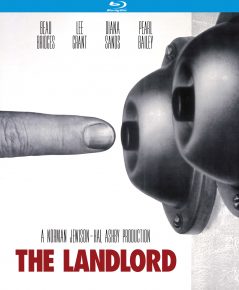 I’ve tended to regard Hal Ashby as being a mite overrated by some of my American colleagues (sorry, but I don’t think Shampoo [1975] is quite up there with La règle du jeu [1939]), so until Kino Lorber brought out a Blu-ray of his first feature as a director, The Landlord (1970), I’d never seen it, having always assumed it was a predictable product of white-liberal Hollywood and not realizing that it was scripted by Bill Gunn (the writer-director of Ganja & Hess [1973]), adapting a novel by another black writer, Kristin Hunter. As luck would have it, I started watching it right after teaching a class in Chicago on a film that was shot during the same period, The Other Side of the Wind, and which feels even more contemporary in relation to psychosexual and racial attitudes (and appears to be recognized as such by my students more than by my contemporaries). So just as Netflix errs in Wind’s prefatory intertitle by referring to it as Orson Welles’ “comeback film” (he was never away—it was the mainstream that needed to come back to him—and if the term is just alluding to Welles’ “return” to the US, this overlooks the fact that much of Wind was made in France), I erred in missing Ashby’s comedy half a century ago while I was living in Paris, assuming that it opened there in that period.
I’ve tended to regard Hal Ashby as being a mite overrated by some of my American colleagues (sorry, but I don’t think Shampoo [1975] is quite up there with La règle du jeu [1939]), so until Kino Lorber brought out a Blu-ray of his first feature as a director, The Landlord (1970), I’d never seen it, having always assumed it was a predictable product of white-liberal Hollywood and not realizing that it was scripted by Bill Gunn (the writer-director of Ganja & Hess [1973]), adapting a novel by another black writer, Kristin Hunter. As luck would have it, I started watching it right after teaching a class in Chicago on a film that was shot during the same period, The Other Side of the Wind, and which feels even more contemporary in relation to psychosexual and racial attitudes (and appears to be recognized as such by my students more than by my contemporaries). So just as Netflix errs in Wind’s prefatory intertitle by referring to it as Orson Welles’ “comeback film” (he was never away—it was the mainstream that needed to come back to him—and if the term is just alluding to Welles’ “return” to the US, this overlooks the fact that much of Wind was made in France), I erred in missing Ashby’s comedy half a century ago while I was living in Paris, assuming that it opened there in that period.
The relative freedom from today’s P.C. thought police found in both Wind and The Landlord is a refreshing reminder that not everything about ’60s counterculture was quite as chaotic or as myopic as some people like to think nowadays. (One precious piece of evidence from The Landlord: a goofy, beautifully acted scene in which Lee Grant’s yuppie character gets plastered on cheap wine with Pearl Bailey.) The interviews with Grant, Beau Bridges, and producer Norman Jewison on the Landlord Blu-ray offer more of historical interest about the period and about Ashby, in spite of the irritating and lazy repetition of the same clips from the film in all three. No matter how apt and funny (if politically incorrect) it might have been to use the word “nigger” twice in the same scene in order to score satirical points in 1970, it’s downright insulting, deflating, and glib to keep replaying that clip in each interview in 2019, as if we were all too dense to get it the first or second time.
***
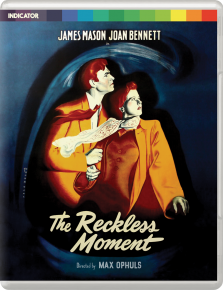 I haven’t read Lutz Bacher’s Max Ophüls in the Hollywood Studios because it isn’t in paperback and Amazon’s hardcover prices start around $76, but his presentation about the shooting of The Reckless Moment (1949) on Powerhouse’s B-region Blu-ray of that film is simply jaw-dropping—possibly the most complete and nuanced account of the production of a Hollywood feature that I’ve encountered anywhere, recounting not only what Ophüls wanted to do and was able to do on every major shot, but also on what specific soundstage or location, plus whom he wanted in his cast and crew and whom he got. I didn’t know that it was even possible to carry out detailed research of this kind, and the fact that Bacher appears to present it all so breezily and exactingly, without any visible notes, is all the more breathtaking. This is reason enough to have the Powerhouse Blu-ray, but the lecture on the film by Todd Haynes that’s included (also produced, like the Bacher feature, by Robert Fischer’s expert Fiction Factory) and the sizable booklet are further incentives. But of course, the main reason for getting this is the beautiful presentation of Ophüls’ exquisite masterpiece, which exudes at every moment the sort of moral suspense I find almost nowhere in Babylon Berlin, even in its most impressive action set pieces. (If this whets your appetite for more Ophüls on English-language Blu-ray, check out Bluebell Films’ restoration of La Ronde [1950].)
I haven’t read Lutz Bacher’s Max Ophüls in the Hollywood Studios because it isn’t in paperback and Amazon’s hardcover prices start around $76, but his presentation about the shooting of The Reckless Moment (1949) on Powerhouse’s B-region Blu-ray of that film is simply jaw-dropping—possibly the most complete and nuanced account of the production of a Hollywood feature that I’ve encountered anywhere, recounting not only what Ophüls wanted to do and was able to do on every major shot, but also on what specific soundstage or location, plus whom he wanted in his cast and crew and whom he got. I didn’t know that it was even possible to carry out detailed research of this kind, and the fact that Bacher appears to present it all so breezily and exactingly, without any visible notes, is all the more breathtaking. This is reason enough to have the Powerhouse Blu-ray, but the lecture on the film by Todd Haynes that’s included (also produced, like the Bacher feature, by Robert Fischer’s expert Fiction Factory) and the sizable booklet are further incentives. But of course, the main reason for getting this is the beautiful presentation of Ophüls’ exquisite masterpiece, which exudes at every moment the sort of moral suspense I find almost nowhere in Babylon Berlin, even in its most impressive action set pieces. (If this whets your appetite for more Ophüls on English-language Blu-ray, check out Bluebell Films’ restoration of La Ronde [1950].)
***
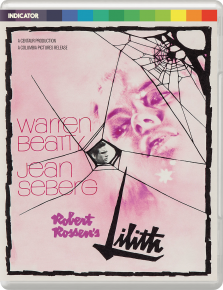 The extras on Powerhouse’s Blu-ray of Robert Rossen’s Lilith (1964), though comparably plentiful, are relatively disappointing, because they don’t tell me nearly enough about the nature of the writer-director’s ongoing conflicts with Warren Beatty—and including a feature-length audio interview with Beatty that doesn’t so much as mention Lilith only added to my frustration. (Furthermore, Jean-André Fieschi—for me one of the key Cahiers du Cinéma critics of the ’60s, even if he overrates Lilith—becomes simply “André Fieschi” in the booklet.) Also, unlike Richard Combs in his booklet essay for this release, and more in agreement with Tom Milne and David Wilson (whose reviews are excerpted), I don’t regard the film as a “satisfying” conclusion to Rossen’s career (although it remains a fascinating experiment in ambiguously mixing objective and subjective methods of storytelling, and contains Jean Seberg’s most accomplished and impressive performance) because, for starters, I consider the title a misnomer: the film is ultimately more about Beatty’s troubled character than it is about Seberg’s. As Mark Rappaport once pointed out to me in an interview, “all of [Seberg’s] scenes are truncated because they have to cut away to Warren Beatty looking at her talking.”
The extras on Powerhouse’s Blu-ray of Robert Rossen’s Lilith (1964), though comparably plentiful, are relatively disappointing, because they don’t tell me nearly enough about the nature of the writer-director’s ongoing conflicts with Warren Beatty—and including a feature-length audio interview with Beatty that doesn’t so much as mention Lilith only added to my frustration. (Furthermore, Jean-André Fieschi—for me one of the key Cahiers du Cinéma critics of the ’60s, even if he overrates Lilith—becomes simply “André Fieschi” in the booklet.) Also, unlike Richard Combs in his booklet essay for this release, and more in agreement with Tom Milne and David Wilson (whose reviews are excerpted), I don’t regard the film as a “satisfying” conclusion to Rossen’s career (although it remains a fascinating experiment in ambiguously mixing objective and subjective methods of storytelling, and contains Jean Seberg’s most accomplished and impressive performance) because, for starters, I consider the title a misnomer: the film is ultimately more about Beatty’s troubled character than it is about Seberg’s. As Mark Rappaport once pointed out to me in an interview, “all of [Seberg’s] scenes are truncated because they have to cut away to Warren Beatty looking at her talking.”
Nonetheless, part of what’s fascinating about Lilith are its auteurist trappings, especially the way Rossen structures it around an unfathomable yet all-knowing woman, as with Piper Laurie’s character in The Hustler (1961), Rita Hayworth’s in They Came to Cordura (1959), Silvana Mangano’s in Mambo (1954), and even, to a lesser extent, Mercedes McCambrige’s in All the King’s Men (1949). (I’m less sure if the case holds for Claire Bloom’s character in Alexander the Great [1956].) There’s a certain collapse of identity in all five cases: Seberg’s character becomes catatonic, Laurie’s commits suicide, Hayworth’s disappointingly reverts from her rebel stance to a more conventionally supportive heroine, and Mangano’s seems to shift her moral principles almost as often as her wardrobes, whereas McCambridge’s spiky character eventually disappears from the plot as an active agent. One might even find traces of this persona in some of the female characters (e.g., Joan Fontaine and Joan Collins) in Island in the Sun (1957), where Rossen was a hired hand directing someone else’s script.
***
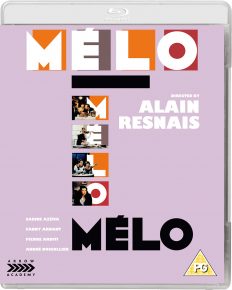 As long as I’m dealing with extras, the most thrilling bundle I’ve encountered on any recent release has to be on Arrow Academy’s Blu-ray of Alain Resnais’ Mélo (1986), specifically the archival interviews with producer Marin Karmitz, actors Pierre Arditi and André Dussollier, script supervisor Sylvette Baudrot, set designer Jacques Saulnier, and Resnais himself. These do an even better job of critical appreciation than Jonathan Romney manages in a new interview (which kindly cites me at the very end), because these people take so much pleasure in recounting and at times even reliving their collective experience in making the film, moment by moment, and their understandings of what the film is doing all seem to be in perfect harmony with one another. Most often, statements by artists about their own art have to be taken with certain amounts of skepticism, but these are so precise and insightful that they strike me as criticism of a high order. (By contrast, the main value of the multiple extras on Arrow’s new Marx Brothers Blu-rays—one devoted to Duck Soup [1933], one to The Cocoanuts [1929] and Animal Crackers [1930], and one to Monkey Business [1931] and Horse Feathers [1932]—is historiographical, not critical.)
As long as I’m dealing with extras, the most thrilling bundle I’ve encountered on any recent release has to be on Arrow Academy’s Blu-ray of Alain Resnais’ Mélo (1986), specifically the archival interviews with producer Marin Karmitz, actors Pierre Arditi and André Dussollier, script supervisor Sylvette Baudrot, set designer Jacques Saulnier, and Resnais himself. These do an even better job of critical appreciation than Jonathan Romney manages in a new interview (which kindly cites me at the very end), because these people take so much pleasure in recounting and at times even reliving their collective experience in making the film, moment by moment, and their understandings of what the film is doing all seem to be in perfect harmony with one another. Most often, statements by artists about their own art have to be taken with certain amounts of skepticism, but these are so precise and insightful that they strike me as criticism of a high order. (By contrast, the main value of the multiple extras on Arrow’s new Marx Brothers Blu-rays—one devoted to Duck Soup [1933], one to The Cocoanuts [1929] and Animal Crackers [1930], and one to Monkey Business [1931] and Horse Feathers [1932]—is historiographical, not critical.)
***
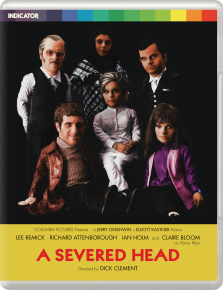 If distant memory serves, I read and enjoyed Iris Murdoch’s A Severed Head a few years after it came out in 1961, having already been a fan of her first novel, Under the Net, with its delightful movie-studio details (it’s always struck me, but apparently nobody else, that the book could be a sure-fire basis for a neat comedy-thriller). This past spring, I finally caught up with the 1970 film adaptation of A Severed Head—written by Frederic Raphael, directed by Dick Clement, and with an ace cast that includes Ian Holm, Richard Attenborough (turning an American shrink into an English one), Lee Remick (sporting a plausible upper-class English accent), and Claire Bloom (channelling a cartoon version of Susan Sontag)—on an all-region Powerhouse Blu-ray, and loved it. (It’s also available on an NTSC DVD from Columbia Pictures, without extras.) The appreciative English extras from Powerhouse, especially the spirited rap by comedian-writer Rob Deering, show I’m not alone in my enjoyment, but it seems that many others reacted very differently and quite negatively when this movie first appeared, starting with Roger Greenspun in The New York Times, who liked the novel and regarded the film as a betrayal. Perhaps he’s right (and I haven’t yet re-read the original to discover whether or not I still like it), but for me, the movie is a hilarious send-up of upscale, would-be Swinging London types trying to be free-spirited ’60s bohemians and then reverting to their worst middle-class crutches and neuroses when they fail. The disparity between the stars’ very different acting styles (Remick seems to be in a different movie entirely) is likely part of what bothered some viewers, including screenwriter Raphael, who faulted Remick and Attenborough in particular (though it should be noted that Raphael maintains a record of misunderstanding his own scripts that culminated in his unpleasantly self-serving book about working with Kubrick on Eyes Wide Shut [1999]). But for me, these stylistic collisions, whether they’re deliberate or not, add pleasurably to the comic weirdness of the whole.
If distant memory serves, I read and enjoyed Iris Murdoch’s A Severed Head a few years after it came out in 1961, having already been a fan of her first novel, Under the Net, with its delightful movie-studio details (it’s always struck me, but apparently nobody else, that the book could be a sure-fire basis for a neat comedy-thriller). This past spring, I finally caught up with the 1970 film adaptation of A Severed Head—written by Frederic Raphael, directed by Dick Clement, and with an ace cast that includes Ian Holm, Richard Attenborough (turning an American shrink into an English one), Lee Remick (sporting a plausible upper-class English accent), and Claire Bloom (channelling a cartoon version of Susan Sontag)—on an all-region Powerhouse Blu-ray, and loved it. (It’s also available on an NTSC DVD from Columbia Pictures, without extras.) The appreciative English extras from Powerhouse, especially the spirited rap by comedian-writer Rob Deering, show I’m not alone in my enjoyment, but it seems that many others reacted very differently and quite negatively when this movie first appeared, starting with Roger Greenspun in The New York Times, who liked the novel and regarded the film as a betrayal. Perhaps he’s right (and I haven’t yet re-read the original to discover whether or not I still like it), but for me, the movie is a hilarious send-up of upscale, would-be Swinging London types trying to be free-spirited ’60s bohemians and then reverting to their worst middle-class crutches and neuroses when they fail. The disparity between the stars’ very different acting styles (Remick seems to be in a different movie entirely) is likely part of what bothered some viewers, including screenwriter Raphael, who faulted Remick and Attenborough in particular (though it should be noted that Raphael maintains a record of misunderstanding his own scripts that culminated in his unpleasantly self-serving book about working with Kubrick on Eyes Wide Shut [1999]). But for me, these stylistic collisions, whether they’re deliberate or not, add pleasurably to the comic weirdness of the whole.
***
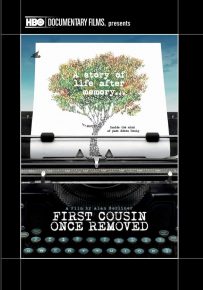 I’m years late in catching up with Alan Berliner’s remarkable First Cousin Once Removed (2013)—available both on DVD and on streaming from Amazon Prime Video—which extends and develops the matching of editing rhythms to the sounds of a typewriter from his Intimate Stranger (1991) to create a complex, loving portrait of Edwin Honig, a relative/poet who miraculously remains a poet even after his memory loss means that he no longer even remembers having been a poet. For me, there’s something truly inspiring about this fact, and beautiful about the ways that Berliner goes about discovering and recording it. I hasten to add that the HBO Documentary DVD has three worthy extras, not least of which is a dramatic 45-minute interview with Berliner by Richard Peña.
I’m years late in catching up with Alan Berliner’s remarkable First Cousin Once Removed (2013)—available both on DVD and on streaming from Amazon Prime Video—which extends and develops the matching of editing rhythms to the sounds of a typewriter from his Intimate Stranger (1991) to create a complex, loving portrait of Edwin Honig, a relative/poet who miraculously remains a poet even after his memory loss means that he no longer even remembers having been a poet. For me, there’s something truly inspiring about this fact, and beautiful about the ways that Berliner goes about discovering and recording it. I hasten to add that the HBO Documentary DVD has three worthy extras, not least of which is a dramatic 45-minute interview with Berliner by Richard Peña.
P.S. After writing all of the above, two more Blu-rays arrived in the mail, each with invaluable critical extras featuring a fellow participant in Movie Mutations: Kino Lorber’s glorious edition of Godard’s Le livre d’image (2018), which includes a feature-length reading of the film by Nicole Brenez, recorded in Rotterdam, that illuminates Godard’s masterpiece in many particulars; and Criterion’s release of Michael Haneke’s 1997 Funny Games (not including Haneke’s 2007 English-language remake), which features a half-hour analysis by Alexander Horwath that not only convinced me to watch the film again (after believing that no critical analysis could do that), but also offers a very plausible way of relating the film to Haneke’s other work.
Jonathan Rosenbaum

